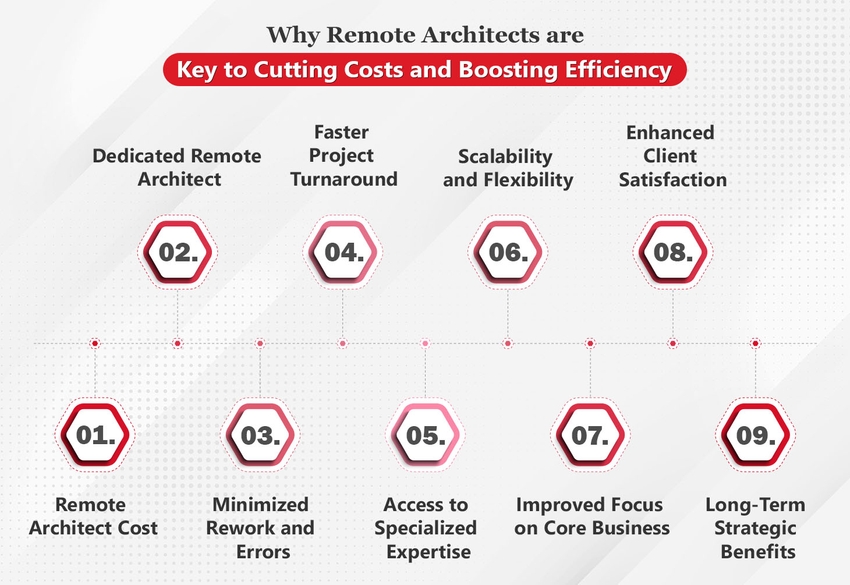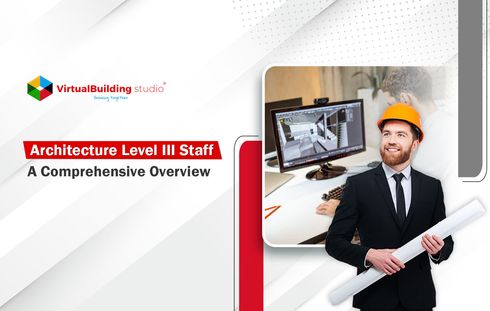
2020 compelled us as a global community to reevaluate some of the ideas we had become used to—outdated approaches with our modern dynamics and behavior. One of the most important realizations was that service location was no longer a limitation.
Experts are no longer restricted to their locality, and face-to-face interactions are no longer essential. The trend of remote work became revolutionary and entered an ever-expanding feedback loop.
For architects and engineers, working remotely offers immense benefits. By utilizing remote architects' skills, businesses can reduce costs, expedite procedures, and access a previously unreachable worldwide talent pool. From 2024 to 2030, the U.S. architectural services market is expected to expand at a compound annual growth rate (CAGR) of 4.2%, from its estimated $73.01 billion in 2023. A change in the operational paradigms of the sector, particularly the engagement with remote architects, is reflected in this rise. By providing companies with a smart combination of cost savings and operational efficiency, remote architects have revolutionized traditional processes.
Outsourcing Architectural Services: A Game-Changer for Modern Design
Outsourcing architectural services entails assigning a skilled external team to handle particular architectural design services that are typically handled internally. This might include a range of activities, including project management, Building Information Modeling (BIM), and producing intricate construction drawings and 3D visualizations.
Depending on the requirements and level of experience needed for a project, architectural companies may decide to outsource to domestic or foreign partners.
Even though architectural design plays a significant role in the outsourcing boom, it's vital to consider the whole picture. The term "architecture outsourcing services" refers to more than just aesthetics.
From careful planning and technical drawings to specialist engineering and construction management, these services provide the full range of architectural competence.
Why Remote Architects Are Crucial to Cost Savings and Operational Efficiency?
Remote architects have reshaped the architectural industry, driving cost savings and operational efficiency. With remote architect teams, businesses ensure faster project deliveries, heightened precision, and scalability tailored to dynamic workloads.

The transformative approach combines specialized knowledge with innovative methodologies, guaranteeing superior project outcomes.
Remote Architect Cost
Conventional recruitment processes involve costs with the job advertisement, recruitment agencies, and onboarding platforms but for architectural outsourcing services, companies access experts without administrative burden.
Myriad of remote hiring platforms has streamlined the process, connecting businesses with qualified and pre-vetted architects at a fraction of the cost of conventional recruitment methods.
Dedicated Remote Architect
Employing remote architects gives companies the financial freedom to pay for the projects they want, and it also helps firms avoid the ongoing costs associated with full-time salaries, benefits, office space, and utilities. Additionally, hiring remote architects for specialized or short-term projects cuts down on wasteful spending.
Minimized Rework and Errors
Remote architects, often selected for their niche expertise, ensure precise project execution, reducing likelihood of the expensive mistakes.
High-quality deliverables from remote professionals save time and money during revision phases which lead to more efficient resource utilization.
Faster Project Turnaround
The main advantage is the pace at which projects are delivered; in contrast to shared in-house teams juggling several tasks, dedicated remote architects concentrate on projects, which cuts down on delays and speeds up project completion.
Access to Specialized Expertise
Hiring remote architects provides access to specific skills. Companies can draw from a varied pool of individuals with unique talents customized to their specific project needs.
Whether it's sustainable design, 3D modeling, or computational design, remote professionals provide distinct insights and technical knowledge that enhance the quality and inventiveness of project deliverables.
Scalability and Flexibility
With remote architects, firms can expand or downsize their teams based on project demands. The scalability ensures that businesses remain agile, accommodating workload fluctuations without disruption. Remote architects can adapt quickly making them invaluable assets for businesses managing dynamic operational landscapes.
Improved Focus on Core Business
Trusting architectural responsibilities with remote experts allows businesses to redirect their focus on the core operations and strategic objectives.
By streamlining the workflow and delegating design and execution to highly skilled professionals, companies optimize internal productivity. Remote architects serve as an extension of the in-house team, ensuring that tasks run efficiently.
Enhanced Client Satisfaction
Client satisfaction is through the delivery of high-quality projects. Businesses ensure that project turnaround is fast with improved deliverables with remote architects.
Improved design quality and timely execution increase confidence and foster long-term client relationships. Satisfied clients are more likely to return and refer others, which drives growth even further.
Long-Term Strategic Benefits
Long-term partnerships with remote architects have consistency in support for future projects. As trust develops, remote architect teams become integral to the workflow of the organization ensuring efficiency and cohesion.
Moreover, remote architects often bring insights into the latest industry trends and emerging technologies, fostering innovation and keeping businesses competitive in a rapidly evolving market.
Collaborating with Remote Architects through VBS
Virtual Building Studio offers two flexible engagement models - hiring remote architects or hiring a remote architects team, to their clientele with a scope for tailored services. A pool of the top 1% of architects and engineers from over 20,000 applications is created after a rigorous screening and interviewing process.
Post a month of training, the professionals from the global talent pool are ready to join any AEC firm and deliver results from the outset.
Unique Features of Resources
- Cultural compatibility: The remote employees integrate seamlessly with the in-house team, fostering a collaborative and productive work culture.
- Round-the-Clock Productivity: Varying time zones enable round-the-clock productivity, enabling timely completion of projects.
- Cost Efficiency: The AEC firms can enjoy the output of four architects for the cost of one, boosting productivity and adhering to budget.
- No Long-term commitments: The AEC companies can collaborate with remote employees with lock-in periods or long-term commitments.
Conclusion
The incorporation of remote architects is altering the architectural industry—a paradigm shift that not only streamlines operations but also allows organizations to innovate and compete in a globalized market.
The cost reductions, scalability, and access to unrivaled expertise make remote architects vital assets. As the demand for adaptable and efficient architectural solutions increases, organizations that adopt this approach can improve project outcomes, boost customer happiness, and assure long-term viability.
With platforms like Toptal and Archipro allowing connections with top-tier talent, now is the time to capitalize on the transformative power of remote architectural services and gain a competitive advantage.




